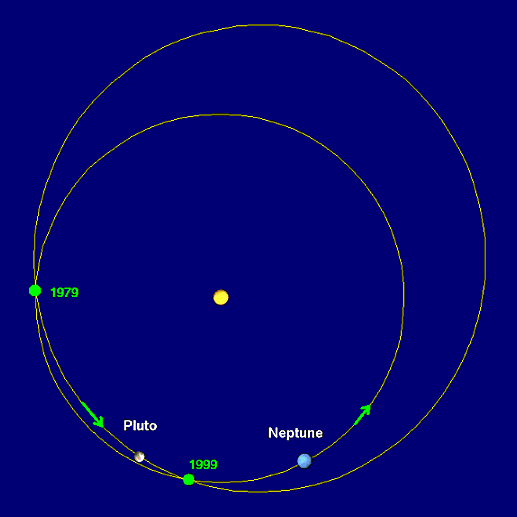General Features of
Pluto
Pluto is on a highly elliptical orbit at an
average separation of almost 40 A. U. from the Sun, with an orbital period of
248 years. Since the planet was only discovered in 1930, we have observed
only a portion of its orbit so far. Further, the orbit is
tilted by about 17 degrees relative to the plane of the ecliptic, much more
than for any other planet. Its equatorial radius of 1150 km is only 20% of that
of the Earth, and its mass is only 0.0025 that of the Earth. Thus, it is by
far the smallest planet, either in mass or diameter. Its period of rotation
appears to be almost 6 1/2 days.
The 9th Planet or the 8th Planet?
Because of the eccentricity of Pluto's orbit, its orbit lies inside that
of Neptune for the period from 1979 to 1999. Thus, strictly, Pluto isn't always the most distant planet, as illustrated in the following diagram.
Of course, we term it the 9th planet because its average separation
from the Sun (length of semimajor axis)
is greater than that for Neptune.

What is Pluto?
This, and other peculiar aspects of Pluto's orbit, have led to some speculation
that Pluto is not really a planet but instead an escaped moon of one of the
gas giant planets, most likely Neptune.
Its composition, as inferred from its density of 2.1 g/cc, is largely ices.
Thus, Pluto is more similar in structure to moons of the gas giant planets than
it is to the terrestrial planets. However, other details may favor an origin
of Pluto independent of Neptune, so this is an open question at present.
Are There Planets Beyond Pluto? What about Sedna?
From time to time there has been speculation of another planet beyond Pluto.
There are now several objects obsevered beyond Pluto that might be considered
planets. However, most planetary scientists don't really feel strongly
that Pluto itself is a planet, but rather consider it to be a large "Kuiper Belt" object.
The Kuiper belt is an orbiting collection of small asteroid like bodies
outside of Pluto's orbit. The ambiguity arises because there is no "official" definition of a planet.
Recently,
Sedna
was discovered, which is about 1/2 the size of Pluto.
Sedna is three times farther than Pluto or Neptune and on a highly
elliptical orbit. It is, as of March 2004, about 90AU from
Earth. Its orbit lies between the Kuiper Belt and the Oort Cloud.
Here is an older
interesting
summary of historical proposals and speculation on additional planets in
the Solar System.

